Pore Type, Pore Structure, and Controlling Factors in the Late Triassic Lacustrine Yanchang Shale, Ordos Basin, China
Abstract
:1. Introduction
2. Geological Setting
3. Samples and Methods
3.1. X-ray Diffraction Analysis
3.2. TOC and Rock–Eval Pyrolysis
3.3. Scanning Electron Microscopy
3.4. Low-Pressure Nitrogen Adsorption
3.5. Porosity Analysis
4. Mineral Composition and Organic Geochemistry
4.1. Petrology and Mineral Composition
4.2. Organic Geochemistry
5. Pore Types and Morphology
5.1. Interparticle Pores (InterP)
5.2. Intraparticle Pores (IntraP)
5.3. Organic Pores
5.4. Pore Networks
6. Pore Surface Area, Pore Volume, Pore Size Distribution, and Porosity
7. Controls on Pore Morphology, SSA, and PSD
7.1. Controls on PV and SSA of Organic Matter
7.2. The Effect of Thermal Maturity on OPs
7.3. Controls on Pore Volume and SSA of Mineral Composition
7.4. The Effect of Diagenesis on Pore Size and PSD
7.5. Controls of Texture, Fabric, and Siltstone Interlayers on PV and PSD
8. Discussions
9. Conclusions
Author Contributions
Funding
Institutional Review Board Statement
Informed Consent Statement
Data Availability Statement
Acknowledgments
Conflicts of Interest
References
- Barrett, E.P.; Joyner, L.G.; Halenda, P.P. The determination of pore volume and area distributions in porous substances. I. computations from nitrogen isotherms. J. Am. Chem. Soc. 1951, 73, 373–380. [Google Scholar] [CrossRef]
- Bennett, R.H.; Hulbert, M.H.; Curry, K.J.; Curry, A.; Douglas, J. Organic matter sequestered in potential energy fields predicted by 3-D clay microstructure model: Direct observations of organo-clay micro-and nanofabric. Mar. Geol. 2012, 315, 108–114. [Google Scholar] [CrossRef]
- Bohacs, K.M.; Passey, Q.R.; Rudnicki, M.; Esch, W.L.; Lazar, O.R. The Spectrum of Fine-Grained reservoirs from “Shale Gas” to “Shale Oil”/ Tight Liquids: Essential Attributes, Key Controls, Practical Characterization. In Proceedings of the IPTC 2013 International Petroleum Technology Conference, Beijing, China, 26-28 March 2013; pp. 1–16. [Google Scholar]
- Brunauer, S.; Emmett, P.H.; Teller, E. Adsorption of Gases in Multimolecular Layers. J. Am. Chem. Soc 1938, 60, 309–319. [Google Scholar] [CrossRef]
- Cai, Z.J.; Lei, Y.H.; Luo, X.R.; Wang, X.Z.; Cheng, M.; Zhang, L.X.; Jiang, C.F.; Zhao, Q.P.; Yin, J.T.; Zhang, L.K. Characteristics and Controlling factors of organic pores in 7th member Yanchang Formation shale in the Southeastern Ordos Basin. Oil Gas Geol. 2019, 40, 1093–1105. (In Chinese) [Google Scholar]
- Cardott, B.J.; Landis, C.R.; Curtis, M.E. Post-oil solid bitumen network in the Woodford Shale, USA—a potential primary migration pathway. Int. J. Coal Geol. 2015, 139, 106–113. [Google Scholar] [CrossRef]
- Chen, Y.F.; Jiang, C.B.; Leung, J.Y.; Wojtanowicz, A.K.; Zhang, D.M. Multiscale characterization of shale pore-fracture system: Geological controls on gas transport and pore size classification in shale reservoirs. J. Petroleum Sci. Eng. 2021, in press. [Google Scholar] [CrossRef]
- Cheng, M.; Luo, X.R.; Lei, Y.H.; Wang, X.Z.; Yu, Y.X.; Zhang, L.X.; Jiang, C.F.; Sun, B.H.; Zhang, L.K. The distribution, fractal characteristics and thickness estimation fo silty laminae and bed in the Zhangjiatan Shale, Ordos Basin. Nat. Gas Geosci. 2015, 26, 845–854. (In Chinese) [Google Scholar]
- Collell, J.; Galliero, G.; Vermorel, R.; Ungerer, P.; Yiannourakou, M.; Montel, F.; Pujol, M. Transport of multicomponent hydrocarbon mixtures in shale organic matter by molecular simulations. J. Phys. Chem. 2015, 119, 22587–22595. [Google Scholar] [CrossRef] [Green Version]
- Curtis, M.E.; Ambrose, R.J.; Sondergeld, C.H. Structural characterization of gas shales on the micro- and nano-scales. In Proceedings of the Canadian Unconventional Resources and International Petroleum Conference, Calgary, AB, Canada, 19-21 October 2010. SPE 137693. [Google Scholar]
- Bernard, S.; Wirth, R.; Schreiber, A.; Schulz, H.M.; Horsefield, B. Formation of nanoporous pyrobitumen residues during maturation of the Barnett Shale (Fort Worth Basin). Int. J. Coal Geol. 2012, 103, 3–11. [Google Scholar] [CrossRef]
- Desbois, G.; Urai, J.L.; Kukla, P.A. Morphology of the pore space in claystones: Evidence from BIB/FIB ion beam sectioning and cryyo-SEM observations. E Earth 2009, 4, 15–22. [Google Scholar]
- Guo, H.J.; He, R.; Jia, W.L.; Peng, P.A.; Lei, Y.H.; Luo, X.R.; Wang, X.Z.; Zhang, L.X.; Jiang, C.F. Pore characteristics of lacustrine shale within the oil window in the Upper Triassic Yanchang Formation, southeastern Ordos Basin, China. Mar. Petroleum Geol. 2018, 91, 279–296. [Google Scholar] [CrossRef]
- Guo, H.J.; Jia, W.L.; Peng, P.A.; Lei, Y.H.; Luo, X.R.; Cheng, M. The organic geochemistry, mineralogy and methane sorption of lacustrine shales from the Upper Triassic Yanchang Formation, Ordos Basin, China. Mar. Petroleum Geol. 2014, 57, 509–520. [Google Scholar] [CrossRef]
- Han, H.; Pang, P.; Li, Z.L.; Shi, P.T.; Guo, C.; Liu, Y.; Chen, S.J.; Lu, J.G.; Gao, Y. Controls of organic and inorganic compositions on pore structure of lacustrine shales of Chang 7 member from Triassic Yanchang Formation in the Ordos Basin, China. Mar. Petroleum Geol. 2019, 100, 270–284. [Google Scholar] [CrossRef]
- Jiang, F.J.; Chen, D.; Wang, Z.F.; Xu, Z.Y.; Chen, J.; Liu, L.; Huyan, Y.Y.; Liu, Y. Pore characteristic analysis of a lacustrine shale: A case study in the Ordos Basin, NW China. Mar. Petroleum Geol. 2016, 73, 554–571. [Google Scholar] [CrossRef]
- Ko, L.T.; Loucks, R.G.; Milliken, K.L. Controls on pore types and pore-size distribution in the Upper Triassic Yanchang Formation, Ordos Basin, China: Implications for pore-evolution models of lacustrine mudrocks. Interpretation 2017, 5, SF127–SF147. [Google Scholar] [CrossRef]
- Kuila, U.; Mccarty, D.K.; Derkowski, A.; Fischer, T.B.; Topor, T.; Prasad, M. Nano-scale texture and porosity of organic matter and clay minerals in organic-rich mudrocks. Fuel 2014, 135, 359–373. [Google Scholar] [CrossRef] [Green Version]
- Kuila, U.; Prasad, M. Specific surface area and pore-size distribution in clays and shales. Geophys. Prospect. 2013, 61, 341–362. [Google Scholar] [CrossRef]
- Lei, Y.H.; Luo, X.R.; Wang, X.Z.; Zhang, L.X.; Jiang, C.F.; Yang, W.; Yu, Y.X.; Cheng, M.; Zhang, L.K. Characteristics of silty laminae in Zhangjiatan Shale of southeastern Ordos Basin, China: Implications for shale gas formation. AAPG Bull. 2015, 99, 661–687. [Google Scholar] [CrossRef]
- Liu, B.; Schiebera, J.; Mastalerzb, M. Combined SEM and reflected light petrography of organic matter in the New Albany Shale (Devonian-Mississippian) in the Illinois Basin: A perspective on organic pore development with thermal maturation. Int. J. Coal Geol. 2017, 184, 57–72. [Google Scholar] [CrossRef]
- Löhr, S.C.; Baruch, E.T.; Hall, P.A.; Kennedy, M.J. Is organic pore development in gas shales influenced by the primary porosity and structure of thermally immature organic matter? Org. Geochem. 2015, 87, 119–132. [Google Scholar] [CrossRef] [Green Version]
- Loucks, R.G.; Reed, R.M.; Ruppel, S.C.; Hammes, U. Spectrum of pore types and networks in mudrocks and a descriptive classification for matrix-related mudrock pores. AAPG Bull. 2012, 96, 1071–1098. [Google Scholar] [CrossRef] [Green Version]
- Loucks, R.G.; Reed, R.M. Scanning-electron-microscope petrographic evidence for distinguishing organic-matter pores associated with depositional organic matter versus migrated organic matter in mudrocks. Gulf Coast Assoc. Geol. Soc. J. 2014, 3, 51–60. [Google Scholar]
- Loucks, R.G.; Ruppel, S.C.; Wang, X.Z. Pore types, pore-network analysis, and pore quantification of the lacustrine shale-hydrocarbon system in the Late Triassic Yanchang Formation in the southeastern Ordos Basin, China. Interpretation 2017, 5, SF63–SF79. [Google Scholar] [CrossRef]
- Milliken, K.L.; Rudnicki, M.; Awwiller, D.N.; Zhang, T.W. Organic matter–hosted pore system, Marcellus formation (Devonian), Pennsylvania. AAPG Bull. 2013, 97, 177–200. [Google Scholar] [CrossRef]
- Reed, R.M.; Loucks, R.G.; Ruppel, S. Comment on “Formation of nano porous pyrobitumen residues during maturation of the Barnett Shale Fort Worth Basin” by Bernard et al. (2012). Int. J. Coal Geol. 2014, 127, 111–113. [Google Scholar] [CrossRef]
- Ross, D.J.K.; Bustin, R.M. The importance of shale composition and pore structure upon gas storage potential of shale gas reservoirs. Mar. Petroleum Geol. 2009, 26, 916–927. [Google Scholar] [CrossRef]
- Schneider, J.; Flemings, P.B.; Day-Stirrat, R.J.; Germaine, J.T. Insights into pore-scale controls on mudstone permeability through resedimentation experiments. Geology 2010, 39, 1011–1014. [Google Scholar] [CrossRef]
- Seewald, J.S. Organic–inorganic interactions in petroleum-producing sedimentary basins. Nature 2003, 426, 327–333. [Google Scholar] [CrossRef] [PubMed]
- Wang, X.Z.; Gao, S.L.; Cao, G. Geological features of Mesozoic continental shale gas in south of Ordos Basin, NW China. Petruleum Explor. Dev. 2014, 41, 294–304. [Google Scholar]
- Wang, X.Z.; Zhang, L.X.; Lei, Y.H.; Yu, Y.X.; Jiang, C.F.; Luo, X.R.; Gao, C.; Yin, J.T.; Cheng, M. Characteristics of migrated solid organic matters and organic pores in low maturity lacustrine shale: A case study of the shale in Chang 7 oil-bearing formation of Yanchang Formation, southeastern Ordos Basin (in Chinese). Acta Petrolei Sin. 2018, 39, 141–151. [Google Scholar]
- Wang, Y.; Liu, L.F.; Cheng, H.F. Pore structure of Triassic Yanchang mudstone, Ordos Basin: Insights into the impact of solvent extraction on porosity in lacustrine mudstone within the oil window. J. Petroleum Sci. Eng. 2020, 195, 107944. [Google Scholar] [CrossRef]
- Yang, H.; Zhang, W.Z. Leading effect of the Seventh Member high-quality source rock of Yanchang Formation in Ordos Basin during the enrichment of low-penetrating oil-gas accumulation. Geochimica 2005, 34, 147–154. (In Chinese) [Google Scholar]
- Yu, Y.X.; Luo, X.R.; Cheng, M. Study on the distribution of extractable organic matter in pores of lacustrine shale: An example of Zhangjiatan Shale from the Upper Triassic Yanchang Formation, Ordos Basin, China. Interpretation 2017, 5, SF109–SF126. [Google Scholar] [CrossRef]
- Yu, Y.X.; Luo, X.R.; Lei, Y.H.; Wang, X.Z.; Zhang, L.X.; Jiang, C.F.; Yang, W.; Cheng, M. Characterization of lacustrine shale pore structure: The Upper-Triassic Yanchang Formation, Ordos Basin, China. J. Nat. Gas Geosci. 2016, 1, 299–308. [Google Scholar] [CrossRef] [Green Version]
- Zhang, W.Z. Controls on organic matter accumulation in the Triassic Chang 7 lacustrine shale of the Ordos Basin, central China. Int. J. Coal Geol. 2017, 183, 38–51. [Google Scholar] [CrossRef]
- Zhang, W.Z.; Yang, H.; Yang, W.W.; Wu, K.; Liu, F. Assessment of geological characteristics of lacustrine shale oil reservoir in Chang7 Member of Yanchang Formation, Ordos Basin. Geochimica 2015, 44, 505–515. (In Chinese) [Google Scholar]
- Zhao, J.; Mountney, N.P.; Liu, C.; Qu, H.; Lin, J. Outcrop architecture of a fluvio-lacustrine succession: Upper Triassic Yanchang Formation, Ordos Basin, China. Mar. Petroleum Geol. 2015, 68, 394–413. [Google Scholar] [CrossRef]
- Zou, C.; Zhang, X.; Luo, P.; Wang, L.; Luo, Z.; Liu, L. Shallow-lacustrine sand-rich deltaic depositional cycles and sequence stratigraphy of the Upper Triassic Yanchang Formation, Ordos Basin, China. Basin Res. 2010, 22, 108–125. [Google Scholar]
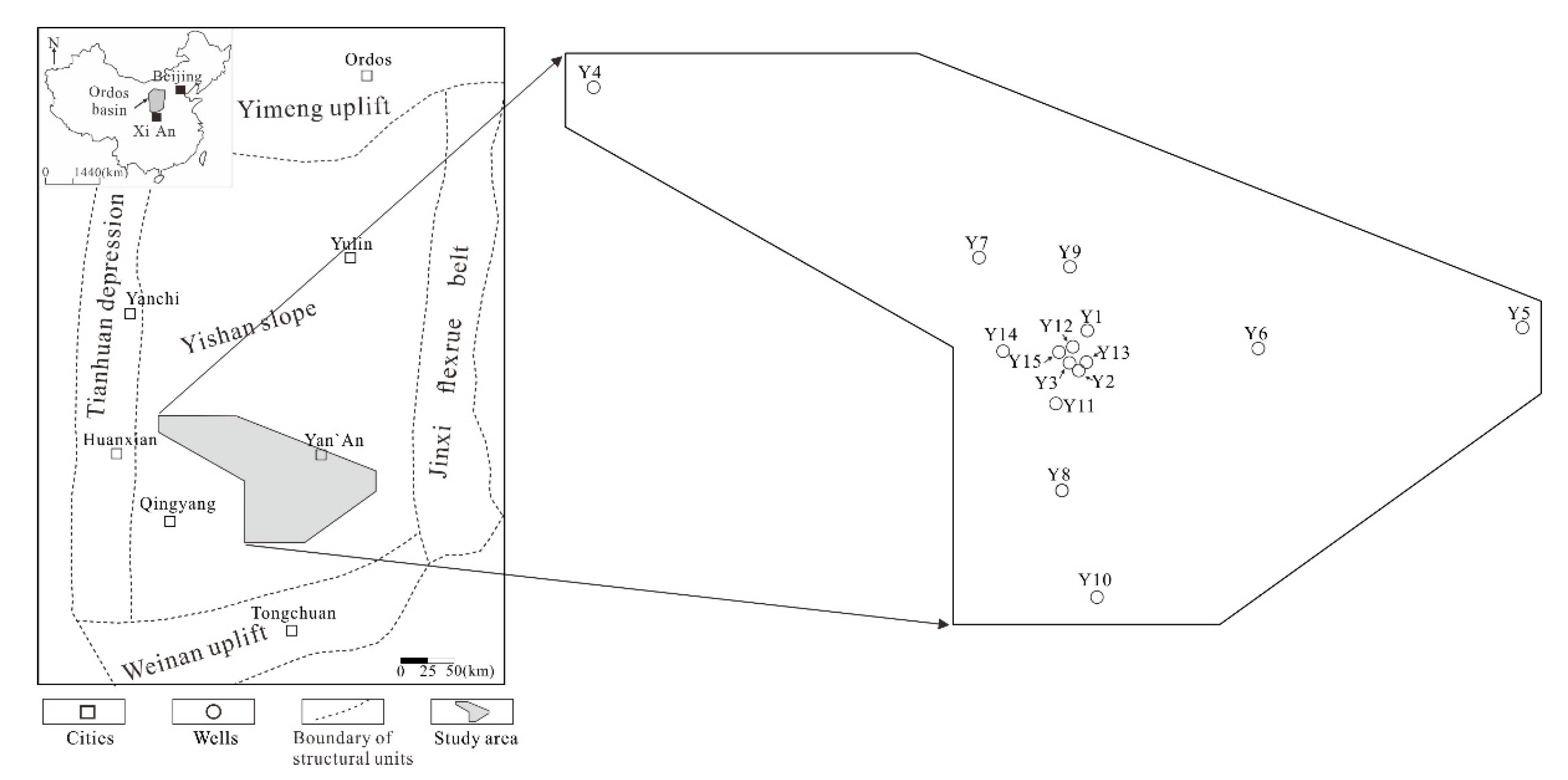

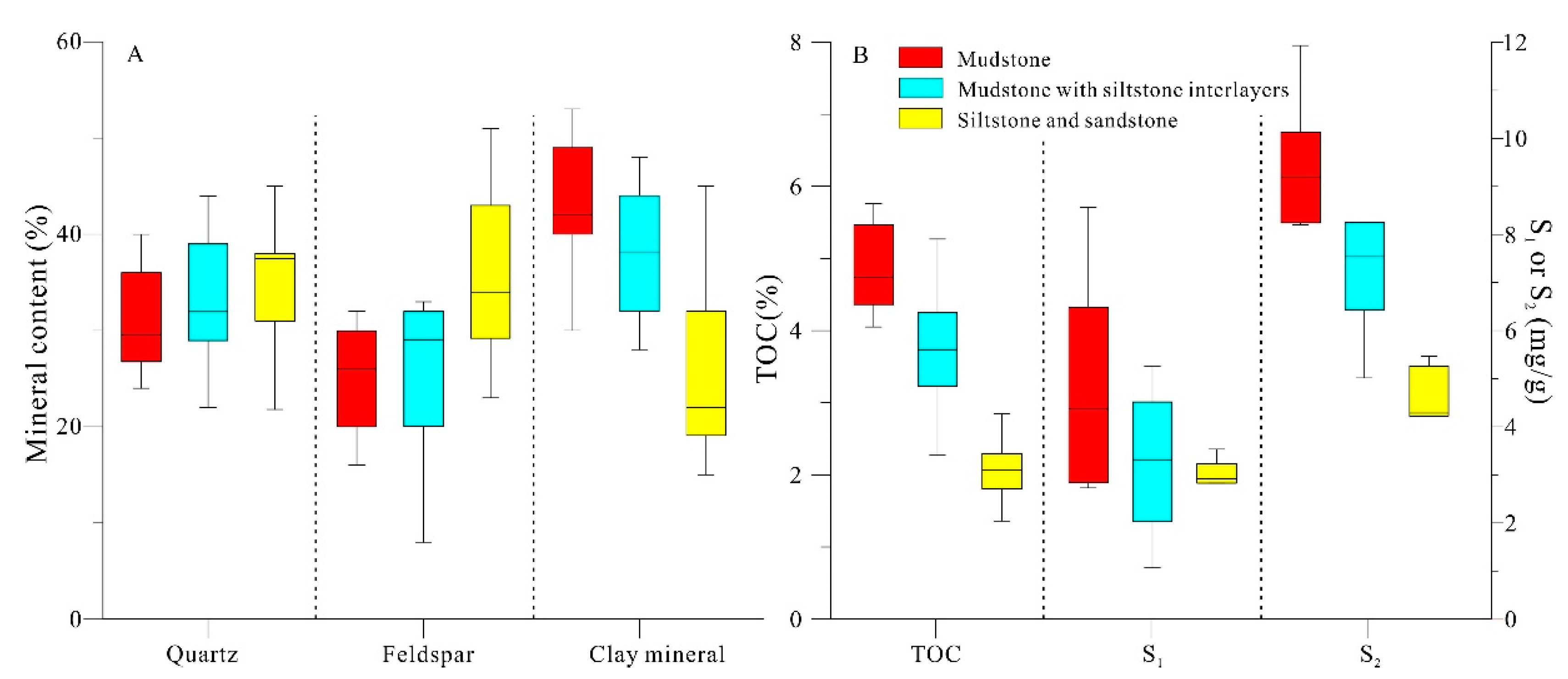



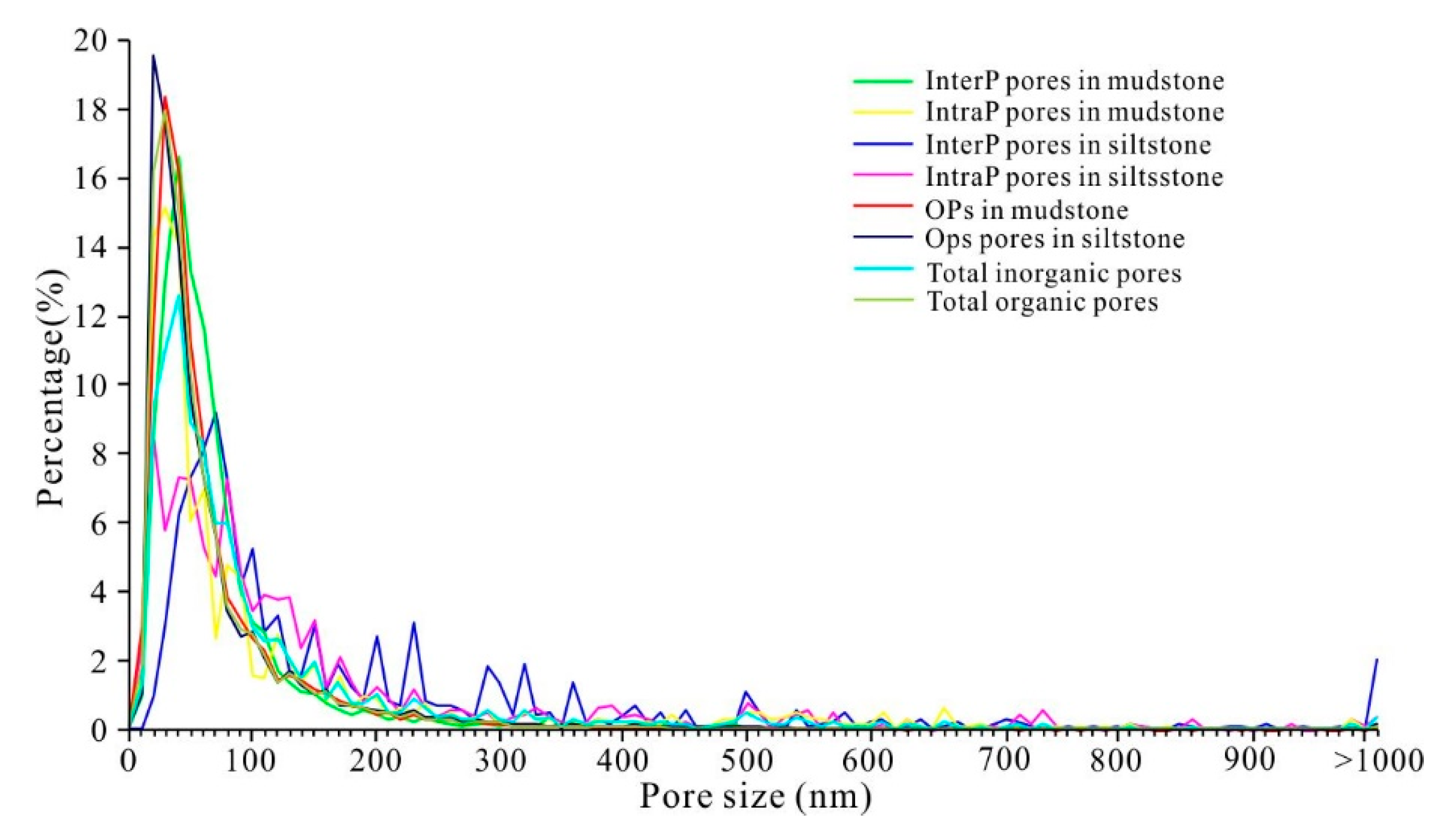
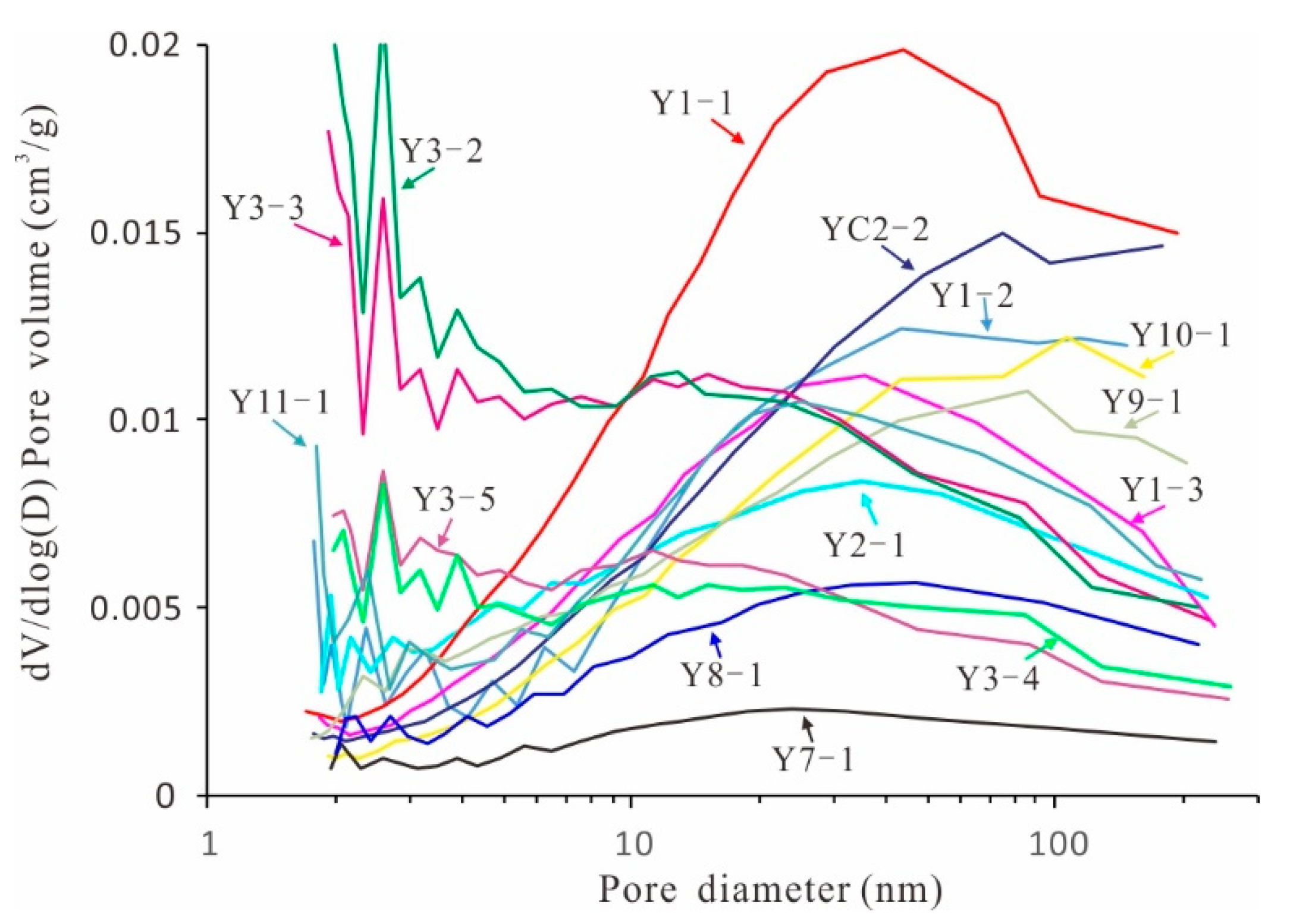
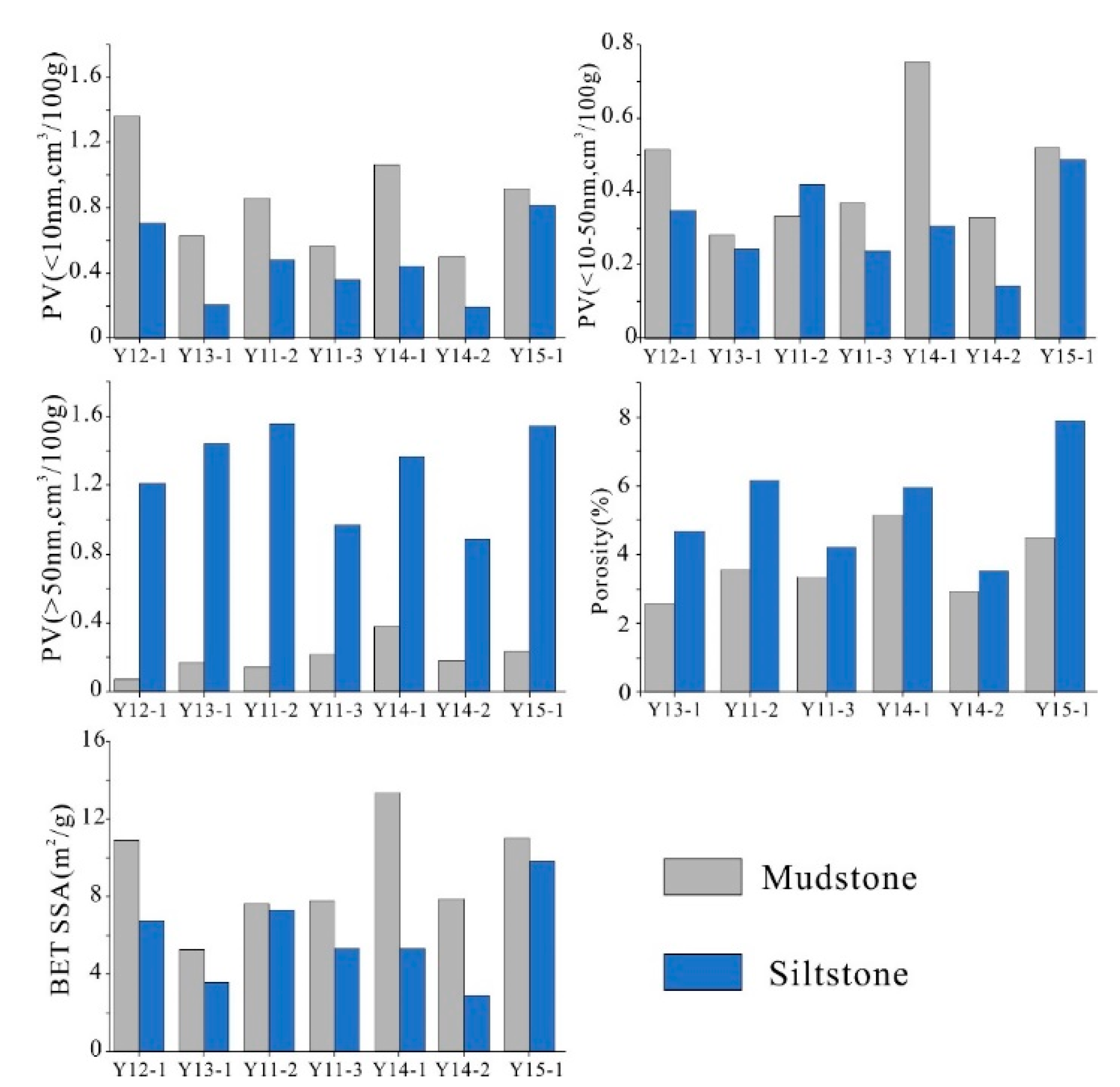


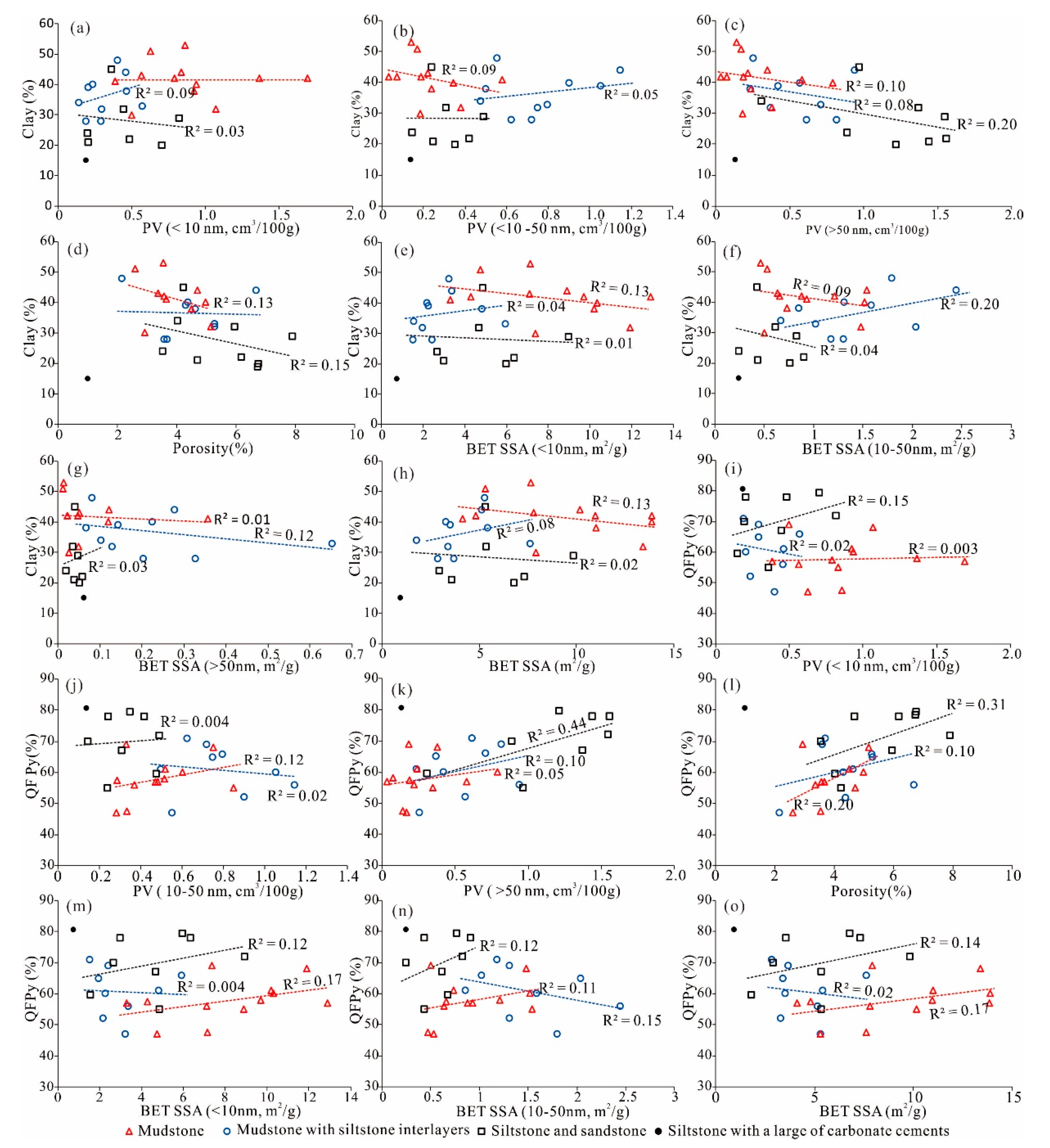
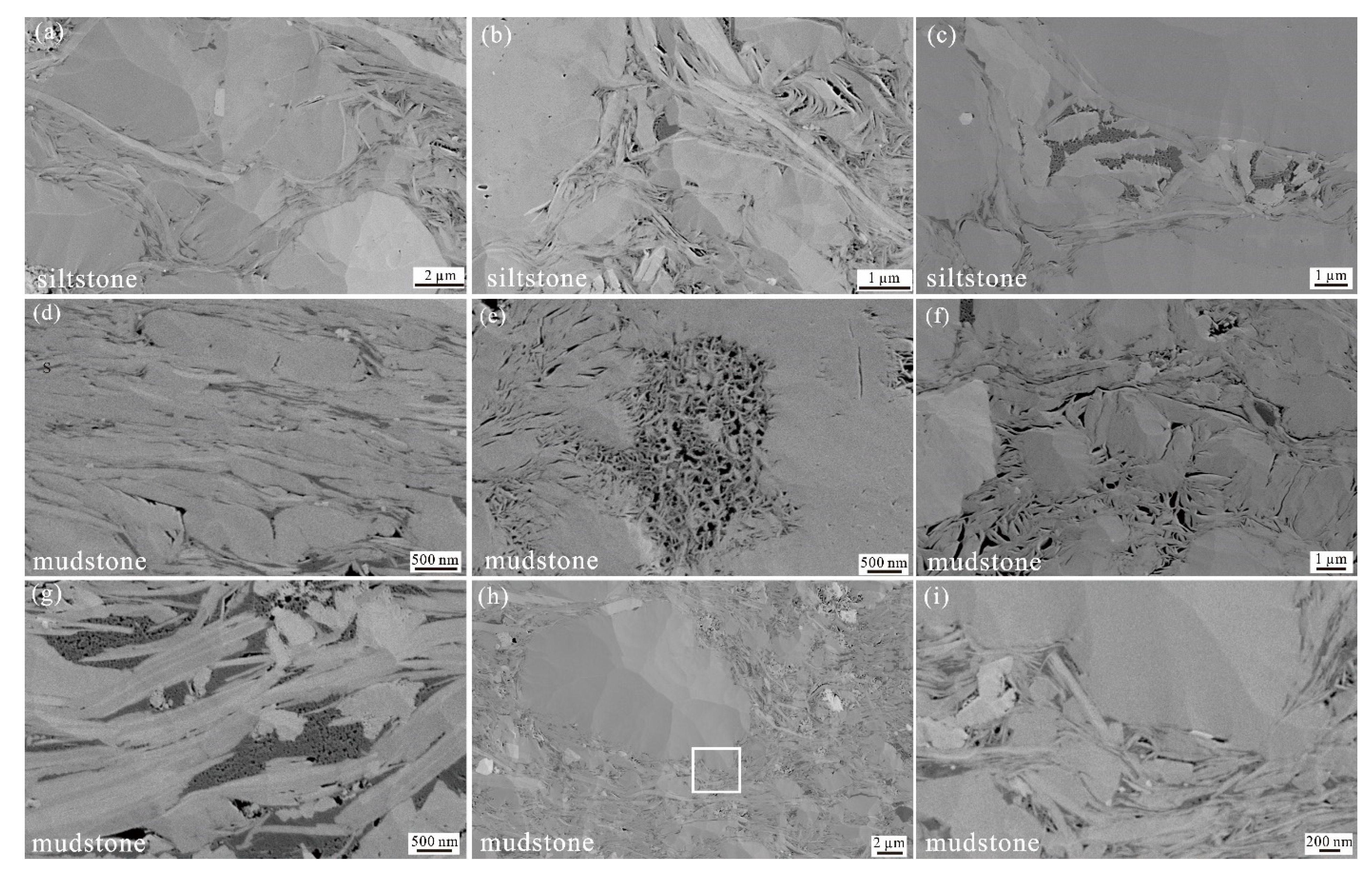


| Well | Sample | Depth (m) | Lithology | Quartz | Feldspar | Calcite | Dolomite | Siderite | Pyrite | Clay |
|---|---|---|---|---|---|---|---|---|---|---|
| Y1 | Y1-1 | 1308.11 | mudstone with interlayers | 44 | 8 | 4 | 44 | |||
| Y1-2 | 1139.98 | 29 | 30 | 1 | 1 | 39 | ||||
| Y1-3 | 1149.74 | 39 | 29 | 1 | 2 | 1 | 28 | |||
| Y2 | Y2-1 | 1519.98 | mudstone | 25 | 28 | 0.5 | 0.5 | 1 | 41 | |
| Y2-2 | 1522.88 | mudstone with interlayers | 30 | 20 | 2 | 1 | 5 | 2 | 40 | |
| Y2-3 | 1530.05 | mudstone | 26 | 30 | 1 | 1 | 42 | |||
| Y3 | Y3-1 | 1340.23 | mudstone with interlayers | 24 | 20 | 5 | 5 | 46 | ||
| Y3-2 | 1348.83 | mudstones | 28 | 29 | 3 | 40 | ||||
| Y3-3 | 1349.64 | 24 | 20 | 1 | 4 | 44 | ||||
| Y3-4 | 1313.14 | mudstone with interlayers | 22 | 25 | 1 | 1 | 3 | 48 | ||
| Y3-5 | 1356.45 | 29 | 31 | 1 | 1 | 38 | ||||
| Y4 | Y4-1 | 2297.31 | sandstone | 45 | 30 | 0.5 | 2 | 3.5 | 19 | |
| Y5 | Y5-1 | 648.55 | siltstone | 43.9 | 29.2 | 5.8 | 1 | 1 | 19.1 | |
| Y6 | Y6-1 | 975.6 | mudstone with interlayers | 36.2 | 25.5 | 0.5 | 1.5 | 36.2 | ||
| Y7 | Y7-1 | 1502.22 | siltstone | 37.5 | 43 | 15 | ||||
| Y8 | Y8-1 | 1184.54 | siltstone | 21.8 | 37.8 | 34 | ||||
| Y9 | Y9-1 | 1505.93 | mudstone with interlayers | 33 | 32 | 32 | ||||
| Y10 | Y10-1 | 1211.19 | 39 | 32 | 28 | |||||
| Y11 | Y11-1 | 1515.21 | 32 | 33 | 1 | 1 | 33 | |||
| Y11-2 | 1419.11 | mudstone | 28 | 17 | 0.5 | 2.5 | 53 | |||
| siltstone | 38 | 40 | 22 | |||||||
| Y11-3 | 1527.65 | mudstone | 40 | 16 | 1 | 43 | ||||
| siltstone | 31 | 23 | 1 | 45 | ||||||
| Y12 | Y12-1 | 1396.76 | mudstone | 32 | 25 | 1 | 1 | 42 | ||
| Y12-2 | 1400.63 | siltstone | 28 | 51 | 0.5 | 0.5 | 20 | |||
| mudstone | 34 | 23 | 0.5 | 0.5 | 42 | |||||
| Y13 | Y13-1 | 1470.21 | mudstone | 29 | 18 | 0.5 | 1.5 | 51 | ||
| siltstone | 34 | 44 | 1 | 21 | ||||||
| Y14 | Y14-1 | 1727.25 | mudstone | 37 | 27 | 0.5 | 0.5 | 4 | 32 | |
| siltstone | 38 | 28 | 1 | 1 | 32 | |||||
| Y14-2 | 1718.41 | mudstone | 37 | 32 | 1 | 30 | ||||
| siltstone | 38 | 34 | 1 | 3 | 24 | |||||
| Y15 | Y15-1 | 1630.4 | mudstone | 30 | 30 | 0.5 | 1.5 | 1 | 38 | |
| siltstone | 35 | 33 | 4 | 29 |
| Sample | Lithology | TOC (wt.%) | Tmax (°C) | S1 (mg/g) | S2 (mg/g) | HI (mg/gTOC) | VR (%) |
|---|---|---|---|---|---|---|---|
| Y1-1 | mudstone with interlayers | 4.65 | 449 | 3.12 | 8.19 | 158 | |
| Y1-2 | 4.12 | 445 | 3.59 | 8.09 | 196 | ||
| Y1-3 | 4.25 | 434 | 4.77 | 11.63 | 230 | 0.94 | |
| Y2-1 | mudstone | 4.35 | 448 | 2.72 | 9.2 | 212 | |
| Y2-2 | mudstone with interlayers | 3.58 | 425 | 3.13 | 6.42 | 167 | 1.09 |
| Y2-3 | mudstone | 5.76 | |||||
| Y3-2 | 5.67 | 457 | 6.48 | 10.12 | 174 | 1.05 | |
| Y3-3 | 5.46 | 453 | 8.56 | 11.92 | 192 | ||
| Y3-4 | mudstone with interlayers | 3.89 | 456 | 3.5 | 6.83 | 182 | |
| Y3-5 | 3.55 | 449 | 5.26 | 6.98 | 206 | ||
| Y4-1 | sandstone | 1.95 | 1.25 | ||||
| Y5-1 | siltstone | 2.17 | 0.5 | ||||
| Y6-1 | mudstone with interlayers | 3.23 | 453 | 1.64 | 8.24 | 255 | 0.85 |
| Y7-1 | siltstone | 1.36 | 414 | 3.53 | 4.28 | 314 | 1.1 |
| Y8-1 | siltstone | 2.24 | 445 | 3.22 | 5.46 | 243 | |
| Y9-1 | mudstone with interlayers | 2.81 | 448 | 2.02 | 5.45 | 194 | |
| Y10-1 | 2.28 | 437 | 1.07 | 5.01 | 234 | ||
| Y11-1 | 5.27 | 443 | 4.51 | 12.12 | 210 | ||
| Y11-2 | mudstone | 4.72 | 453 | 4.39 | 8.24 | 189 | |
| siltstone | 2.85 | 452 | 2.92 | 5.26 | 190 | ||
| Y11-3 | mudstone | 4.36 | |||||
| siltstone | 1.81 | 448 | 0.39 | 2.16 | 213 | ||
| Y12-1 | siltstone | 1.5 | |||||
| Y12-2 | mudstone | 4.62 | 169 | ||||
| Y13-1 | mudstone | 4.05 | 450 | 2.84 | 4.67 | 183 | |
| Y15-1 | mudstone | 4.75 | |||||
| siltstone | 2.3 | 453 | 2.82 | 4.22 | 115 |
| Sample | lithology | PV (<10 nm) | PV (10–50 nm) | PV (>50 nm) | Total PV | Porosity | SSA (<10 nm) | SSA (10–50 nm) | BET SSA |
|---|---|---|---|---|---|---|---|---|---|
| Y1-1 | mudstone with interlayers | 0.456 | 1.145 | 0.937 | 2.538 | 6.67 | 3.357 | 2.444 | 5.121 |
| Y1-2 | 0.201 | 1.053 | 0.416 | 1.670 | 4.29 | 2.245 | 1.585 | 3.494 | |
| Y1-3 | 0.290 | 0.719 | 0.815 | 1.823 | 3.57 | 2.406 | 1.305 | 3.673 | |
| y2-1 | mudstone | 0.384 | 0.480 | 0.578 | 1.443 | 3.65 | 3.296 | 0.932 | 4.122 |
| y2-2 | mudstone with interlayers | 0.234 | 0.901 | 0.567 | 1.702 | 4.37 | 2.162 | 1.310 | 3.271 |
| y2-3 | mudstone | 1.688 | 0.471 | 0.031 | 2.190 | 3.56 | 12.900 | 0.880 | 13.837 |
| Y3-2 | 0.936 | 0.601 | 0.790 | 2.326 | 4.96 | 10.310 | 1.516 | 13.867 | |
| Y3-3 | 0.832 | 0.847 | 0.349 | 2.029 | 4.69 | 8.888 | 1.537 | 10.155 | |
| Y3-4 | mudstone with interlayers | 0.400 | 0.550 | 0.253 | 1.203 | 2.13 | 3.212 | 1.793 | 5.273 |
| Y3-5 | 0.463 | 0.497 | 0.233 | 1.193 | 4.62 | 4.816 | 0.854 | 5.402 | |
| Y4-1 | sandstone | 6.72 | |||||||
| Y7-1 | siltstone | 0.186 | 0.138 | 0.131 | 0.455 | 0.99 | 0.747 | 0.249 | 0.926 |
| Y8-1 | 0.145 | 0.473 | 0.305 | 0.923 | 4.02 | 1.531 | 0.672 | 1.777 | |
| Y9-1 | mudstone with interlayers | 0.291 | 0.746 | 0.370 | 1.407 | 5.27 | 1.949 | 2.033 | 3.386 |
| Y10-1 | 0.188 | 0.622 | 0.614 | 1.424 | 3.67 | 1.510 | 1.179 | 2.838 | |
| Y11-1 | 0.567 | 0.796 | 0.709 | 2.072 | 5.26 | 5.920 | 1.020 | 7.591 | |
| Y11-2 | mudstone | 0.857 | 0.332 | 0.140 | 1.329 | 3.54 | 7.140 | 0.467 | 7.620 |
| siltstone | 0.481 | 0.418 | 1.556 | 2.455 | 6.16 | 6.340 | 0.905 | 7.305 | |
| Y11-3 | mudstone | 0.564 | 0.369 | 0.218 | 1.151 | 3.36 | 7.100 | 0.639 | 7.792 |
| siltstone | 0.360 | 0.237 | 0.965 | 1.562 | 4.22 | 4.840 | 0.430 | 5.310 | |
| Y12-1 | mudstone | 1.364 | 0.515 | 0.072 | 1.951 | 9.690 | 1.210 | 10.939 | |
| siltstone | 0.704 | 0.349 | 1.212 | 2.265 | 6.75 | 5.950 | 0.764 | 6.768 | |
| Y12-2 | mudstone | 0.787 | 0.287 | 0.187 | 1.261 | 4.280 | 0.657 | 4.810 | |
| Y13-1 | mudstone | 0.625 | 0.280 | 0.168 | 1.073 | 2.58 | 4.740 | 0.530 | 5.287 |
| siltstone | 0.204 | 0.244 | 1.439 | 1.886 | 4.68 | 2.980 | 0.436 | 3.550 | |
| Y14-1 | mudstone | 1.067 | 0.751 | 0.379 | 2.197 | 5.14 | 11.900 | 1.480 | 13.401 |
| siltstone | 0.442 | 0.306 | 1.368 | 2.117 | 5.94 | 4.670 | 0.613 | 5.316 | |
| Y14-2 | mudstone | 0.497 | 0.330 | 0.182 | 1.009 | 2.92 | 7.370 | 0.503 | 7.900 |
| siltstone | 0.194 | 0.143 | 0.884 | 1.222 | 3.52 | 2.650 | 0.246 | 2.911 | |
| Y15-1 | mudstone | 0.921 | 0.519 | 0.237 | 1.676 | 4.48 | 10.200 | 0.733 | 10.996 |
| siltstone | 0.816 | 0.488 | 1.543 | 2.847 | 7.88 | 8.940 | 0.825 | 9.815 |
Publisher’s Note: MDPI stays neutral with regard to jurisdictional claims in published maps and institutional affiliations. |
© 2021 by the authors. Licensee MDPI, Basel, Switzerland. This article is an open access article distributed under the terms and conditions of the Creative Commons Attribution (CC BY) license (https://creativecommons.org/licenses/by/4.0/).
Share and Cite
Cheng, M.; Lei, Y.; Luo, X.; Zhang, L.; Wang, X.; Zhang, L.; Jiang, C.; Yin, J. Pore Type, Pore Structure, and Controlling Factors in the Late Triassic Lacustrine Yanchang Shale, Ordos Basin, China. Energies 2021, 14, 3053. https://doi.org/10.3390/en14113053
Cheng M, Lei Y, Luo X, Zhang L, Wang X, Zhang L, Jiang C, Yin J. Pore Type, Pore Structure, and Controlling Factors in the Late Triassic Lacustrine Yanchang Shale, Ordos Basin, China. Energies. 2021; 14(11):3053. https://doi.org/10.3390/en14113053
Chicago/Turabian StyleCheng, Ming, Yuhong Lei, Xiaorong Luo, Likuan Zhang, Xiangzeng Wang, Lixia Zhang, Chengfu Jiang, and Jintao Yin. 2021. "Pore Type, Pore Structure, and Controlling Factors in the Late Triassic Lacustrine Yanchang Shale, Ordos Basin, China" Energies 14, no. 11: 3053. https://doi.org/10.3390/en14113053





